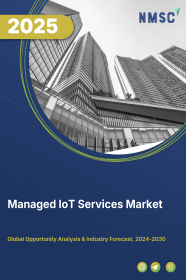
Managed IoT Service Market by Service Type (Infrastructure management services, Security management services, Network management services, Data management services, and Device management services), by Deployment Type (Cloud and On-premise), by Application (Smart Manufacturing, Smart metal, IT & Telecom, Smart Transportation, Smart energy & utilities, Smart buildings, and Others) and Others - Global Opportunity Analysis and Industry Forecast 2024-2030
Market Definition
The Managed IoT Services Market size was valued at USD 41.06 billion in 2023 and is predicted to reach USD 186.32 billion by 2030 with a CAGR of 24.25% from 2024-2030.
Managed IoT services refers to the provision of end-to-end solutions for the deployment, management, and maintenance of Internet of Things (IoT) devices & systems. These services include installation and configuration of IoT devices, provision of connectivity & data management services, as well as ongoing support and maintenance of the devices & systems. These services are provided by a variety of providers, including telecommunications companies, and IT service providers. It is designed to help organizations and businesses of all sizes to easily implement IoT solutions and take advantage of IoT technology. It also used for improving efficiency, automation, and data analytics in IoT systems. These services are customized to meet the specific needs of different industries such as manufacturing, retail, healthcare, and transportation.
Market Dynamics and Trends
The growing deployment of cloud computing and 5G networks facilitating efficient & cost-effective management of IoT devices is boosting the growth of the managed IoT services market. According to the 5G America, an industry trade organization, the global 5G wireless connections increased by 76% from the end of 2021 to the end of 2022, reaching up to 1.05 billion and it is expected to reach the mark of 5.9 billion by the end of 2027.
Also, with the rising adoption of digital transformation by various businesses and industries there's a surge demand for seamless connectivity and data management across diverse devices, which in turn fuels the growth of the market.
According to the International Telecommunication Union, as of 2021, approximately 4.9 billion people, or about 63% of the global population, are using the Internet. This marks a 17% increase compared to previous years, and it's estimated that nearly 800 million individuals have connected to the Internet since 2019. This trend is expected to drive significant market growth as digitalization expands across various sectors.
Moreover, the emergence of Industry 4.0 and integration of advanced technologies such as IoT, artificial intelligence (AI), & automation in manufacturing processes to achieve increased efficiency, flexibility, and intelligence is accelerating the market growth.
However, implementing managed IoT services can be expensive, particularly for small and medium-sized businesses. The initial investment includes hardware, software, and ongoing subscription costs, which restraints the growth of the market.
On the contrary, the integration of blockchain technology into managed IoT services is expected to create ample growth opportunities for the market in the future. Blockchain will enhance IoT security by providing tamper-resistant data storage and transparent transaction records, protecting data integrity and ensure trust in IoT ecosystems.
Market Segmentations and Scope of the Study
The managed IoT services market is segmented on the basis of service type, deployment type, application, end user and region. On the basis of service type, the market is divided into infrastructure management services, security management services, network management services, data management services, and device management services. On the basis of deployment type, the market is classified into cloud and on-premise. On the basis of application, the market is categorized into smart manufacturing, smart metal, information technology (IT) & telecom, smart transportation, smart energy & utilities, smart buildings, and others. On the basis of end user, the market is bifurcated into energy and utilities, transportation & logistics manufacturing, agriculture, healthcare, BFSI, retail, government & defense, and others. Geographic breakdown and analysis of each of the aforesaid segments includes regions comprising of North America, Europe, Asia-Pacific, and RoW.
Geographical Analysis
North America holds the dominant share of the managed IoT services market and is expected to continue its dominance during the forecast period. This is due to the increasing implementation of IoT devices in the healthcare sector to manage patient’s data effectively and securely. For instance, in May 2021, Cynerio secured USD 30 million in Series B funding in the North American Region to Install IoT enabled devices in hospitals & healthcare systems.
Also, the growing digitalization in North America is significantly boosting the expansion of the managed IoT services market in the region. According to the European Investment Bank, 78% U.S manufacturing firm reports having adopted at least on digital technology. As businesses and industries increasingly embrace digital technologies, the demand for IoT solutions to enhance efficiency, gather valuable data, and optimize operations has surged significantly in the region.
On the other hand, Asia-Pacific region is expected to show a steady rise in the managed IoT services market due to the rapid development of smart cities in countries such as China and India. The implementation of smart cities requires a large number of IoT devices to be deployed that drives the demand for managed IoT services in the region.
For instance, in May 2022, Japan's NEC Corporation, led by Chairman Nobuhiro Endo, announced its participation in India's Smart Cities and 5G projects. This collaboration is expected to bolster India's efforts in developing smart cities and advancing 5G technology, further driving the growth of the managed IoT services market in the region.
Moreover, the presence of major key players such as Infosys, Tech Mahindra Limited, HCL Technologies Limited, and Wipro Limited that are adopting various strategies including partnership boost the growth of managed IoT services market in this region.
For instance, in June 2022, Tech Mahindra Limited partnered with Anritsu to launch an IoT experience lab. This partnership enabled efficient testing of 5G devices used in emerging IoT cases, that helped original equipment manufacturers (OEMs) to minimize failures in the manufacturing process.
Competitive Landscape
The managed IoT services market comprises of various market players such as Cisco Systems Inc., Cognizant, Google Inc., Harman International Inc., HCL Technologies Limited, Infosys Limited, Tata Consultancy Services, Tech Mahindra Limited, IBM Corporation and Wipro Limited. These market players are adopting product launch and partnerships as their key developmental strategy across various regions to maintain their dominance in the managed IoT services market.
For instance, in May 2023, NTT and Cisco launched IoT as a Service for enterprise customers, offering a comprehensive solution to integrate IoT technologies into their operations seamlessly. This collaboration strengthens the cloud ERP suites market by providing enhanced IoT capabilities within enterprise software ecosystems.
Also, in March 2022, Infosys partnered with EY to support organizations in their end-to-end business transformation and growth. This partnership focused on deploying digital assets and building services & co-developing solutions using emerging technologies such as cloud, IoT, blockchain, and AI.
Key Benefits
-
The The report provides quantitative analysis and estimations of the managed IoT services market from 2024 to 2030, which assists in identifying the prevailing market opportunities.
-
The study comprises a deep-dive analysis of the managed IoT services market including the current and future trends to depict prevalent investment pockets in the market.
-
Information related to key drivers, restraints, and opportunities and their impact on the managed IoT services market is provided in the report.
-
Competitive analysis of the players, along with their market share is provided in the report.
-
SWOT analysis and Porters Five Forces model is elaborated in the study.
-
Value chain analysis in the market study provides a clear picture of roles of stakeholders.
Key Market Segments
By Service Type
-
Infrastructure management services
-
Security management services
-
Network management services
-
Data management services
-
Device management services
By Deployment Type
-
Cloud
-
On-premise
By Application
-
Smart manufacturing
-
Smart metal
-
IT & telecom
-
Smart transportation
-
Smart energy & utilities
-
Smart buildings
-
Others
By End User
-
Energy and Utilities
-
Transportation & Logistics Manufacturing
-
Agriculture
-
Healthcare
-
BFSI
-
Retail
-
Government & Defense
-
Others
By Region
-
North America
-
The U.S
-
Canada
-
Mexico
-
-
Europe
-
The UK
-
Germany
-
France
-
Italy
-
Spain
-
Denmark
-
Netherlands
-
Finland
-
Sweden
-
Norway
-
Russia
-
Rest of Europe
-
-
Asia-Pacific
-
China
-
Japan
-
India
-
South Korea
-
Australia
-
Indonesia
-
Singapore
-
Taiwan
-
Thailand
-
Rest of Asia-Pacific
-
-
Rest of the World (RoW)
-
Latin America
-
Middle East
-
Africa
-
REPORT SCOPE AND SEGMENTATION:
|
Parameters |
Details |
|
Market Size in 2023 |
USD 41.06 Billion |
|
Revenue Forecast in 2030 |
USD 186.32 Billion |
|
Revenue Growth Rate |
CAGR of 24.25% from 2024 to 2030 |
|
Analysis Period |
2023–2030 |
|
Base Year Considered |
2023 |
|
Forecast Period |
2024–2030 |
|
Market Size Estimation |
Billion (USD) |
|
Growth Factors |
|
|
Countries Covered |
28 |
|
Companies Profiled |
10 |
|
Market Share |
Available for 10 companies |
|
Customization Scope |
Free customization (equivalent up to 80 working hours of analysts) after purchase. Addition or alteration to country, regional, and segment scope. |
|
Pricing and Purchase Options |
Avail customized purchase options to meet your exact research needs. |
KEY PLAYERS
-
Cisco Systems Inc.
-
Cognizant
-
Google Inc.
-
Harman International Inc.
-
HCL Technologies Limited
-
Infosys Limited
-
Tata Consultancy Services
-
Tech Mahindra Limited
-
IBM Corporation
-
Wipro Limited




















 Speak to Our Analyst
Speak to Our Analyst
























